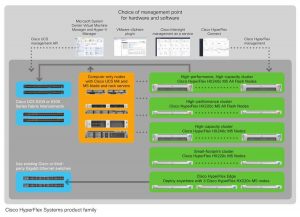Cisco Hyperflex: Time for HCI Compromise Over
Latest evolution in delivering data centre infrastructure
This is a Press Release edited by StorageNewsletter.com on June 21, 2018 at 2:10 pm
This blog was written by Rodney Hamill, director, sales, data centre and cloud, Cisco Systems Australia.
Cisco Hyperflex: The Time for HCI Compromise is Over
Hyperconverged infrastructure (HCI) – it’s a bit of a mouthful but the truth is it’s not half as complicated as it sounds.
While the concept has only been mainstream for a few years, HCI is the fastest-growing segment of the market for integrated systems.
In fact, Gartner, Inc. predicts it will grow from a niche industry in 2012 to a $5 billion industry by 2019 [i], while a recent ESG Lab report states that 85% of businesses currently use, or are planning to use, HCI solutions.
That said, I believe HCI will become mainstream in the Australian and New Zealand (ANZ) market a lot sooner than the rest of the world. From IP telephony to cloud, the ANZ market has always lead the way in technology adoption. And as I’ll discuss below, Cisco Technology, Inc.‘s HyperFlex is primed to lead the way in the HCI market.
 But first, what is HCI and Cisco HyperFlex?
But first, what is HCI and Cisco HyperFlex?
HCI, in a nutshell, is the latest evolution in delivering data centre infrastructure. It’s flexible, simpler to manage and was introduced to leverage the economic benefits of software-defined storage.
HyperFlex HX
Cisco takes the benefits for HCI further. Designed with an end-to-end software-defined infrastructure approach, the platform eliminates the compromises found in other hyperconverged products. We combine software-defined computing using UCS servers, software-defined storage using the HyperFlex HX Data Platform software, and software-defined networking (SDN) using Cisco unified fabric, which integrates smoothly with Application Centric Infrastructure (ACI)
HyperFlex systems deliver the agility, scalability, and pay-as- you-grow economics of the cloud, but with the benefits of on-premises infrastructure.
It supports a broad range of applications and workloads for data centres and remote locations and brings increased operational efficiency and adaptability to more workloads in your data centre.
Click to enlarge
Key Benefits
One of the biggest benefits of HyperFlex is that it integrates into existing management suites. The company’s UCS provides a single point of connectivity and hardware management that integrates HyperFlex HX-Series all-flash or hybrid nodes and a variety of UCS servers into a single unified cluster.
So if you’re an existing UCS customer and you’ve found a use case for HyperFlex in your environment, you can use the same set of tools for managing the entire environment.
In earlier evolution phases of HCI, most products focused on simplicity and overlooked performance. With HyperFlex, however, performance is key, while simplicity and ease of management is a given.
ESG Labs on HyperFlex
The next generation of HCI cannot rely only on simplicity and automation. IT teams must start thinking about running mission-critical workloads.
A recent ESG Labs performance report recently showed that HyperFlex is the best placed HCI solution to run these mission-critical workloads.
The ESG report noted that “Cisco delivers an HCI solution that provides the essential simplicity and cost-efficiency features of HCI, but also the consistent high performance that has been missing”.
The report benchmarked across all major HCI vendors and also found that the company’s highly integrated approach in providing compute, network, and storage in a fully integrated stack was not evident in other HCI solutions.
Click to enlarge
Which businesses are set to benefit?
Two words: any organisation.
Applications range from big businesses looking to use HyperFlex for specific use cases – for example virtual desktop infrastructure – to smaller businesses looking for a solution to do everything.
Required infrastructure and planning
HyperFlex is turnkey out of the box and scales up. It’s almost like a Lego set. You can scale it more and more as you go.
There are three main things customers need to consider when looking at HCI.
The first is target workloads and applications: what workloads and applications in your business environment are best suited for HCI?
Where our competitors would go in and say ‘it can all go on hyperconvergence’. We say ‘yes it can, but should it all go on? And what are benefits of putting it all on there?’
The second consideration is integration to existing environments: Assuming that in many cases HCI will not immediately fully replace existing environments, simply adding a HCI solution may increase total cost of ownership as there will now be two environments to manage.
With HyperFlex fully integrating to the company’s existing UCS management facilities it allows customers to evolve in a controlled and planned manner.
The third consideration is to ask ‘how will it scale?’. Different resources may be needed at different times.
For example, you may have sufficient CPU and memory but be short on storage. We handle our scaling very differently from other HCI providers. The firm’s HyperFlex system lets IT managers independently scale up computing, storage and networking resources to avoid over-provisioning in any one area.
Final word
Organisations today must be extremely flexible, with the ability to scale quickly and affordably.
This is extremely difficult to achieve with silos of compute, network, and storage gear that are static and require individual management.
Cisco delivers an HCI solution that provides the essential simplicity and cost-efficiency features of HCI, but also the consistent high performance that has been missing.
Resources:
HyperFlex
ESG Lab Validation: Cisco HyperFlex Report
[I] From Data Center Knowledge: Why Hyperconverged Infrastructure is so Hot
















 Subscribe to our free daily newsletter
Subscribe to our free daily newsletter


